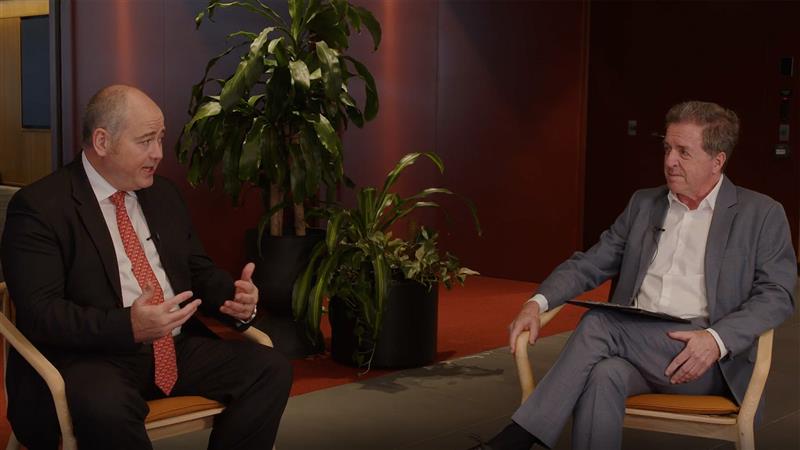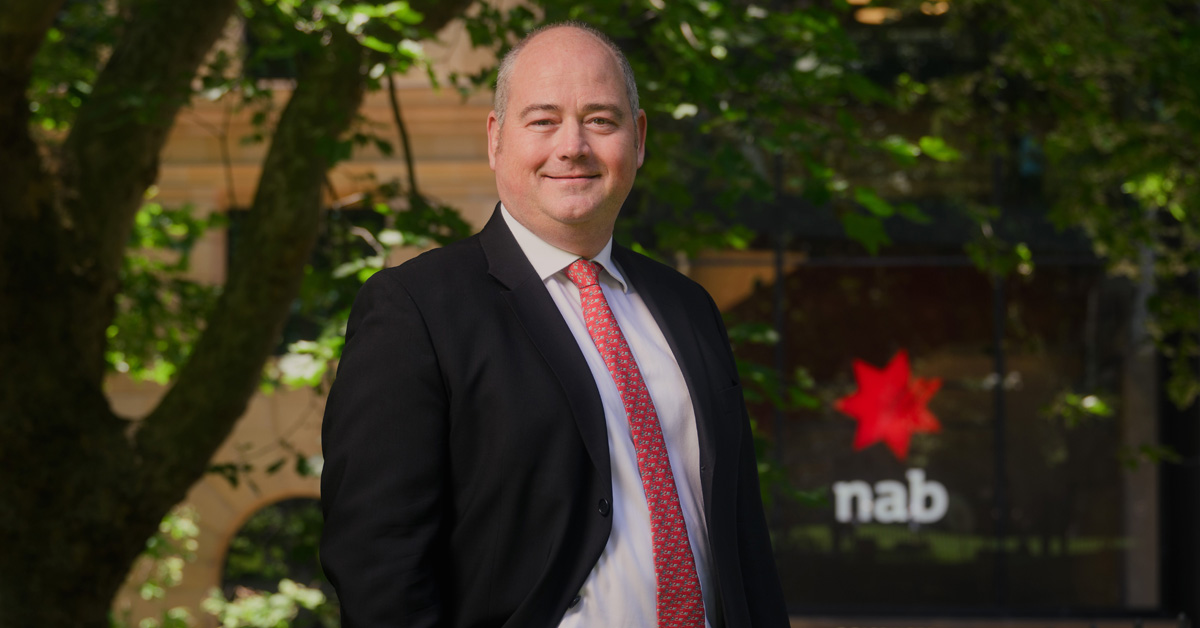Below is a transcript from NAB’s 2022 Full Year Results media conference on 9 November 2022 with NAB CEO Ross McEwan.
NAB GROUP CEO, ROSS McEWAN:
Good morning.
We’ve just released our results for Full Year 2022 and I’m pleased to say NAB has again delivered a strong performance.
It has been almost three years since we refreshed our strategy, and we continue to make good progress by staying focussed on customers and colleagues. Improving earnings and shareholder returns reflect this.
Key to this has been doing what we said we would, executing well and just getting the basics right.
NAB is a better bank, but there’s more to do.
There are a couple of elements to highlight:
- Business and Private Bank performed strongly, with small and medium business lending growth of 13 per cent and market share gains. We’ve got more bankers in more places, we’re helping more customers and we’re doing more business together. Our relationships, some that go back generations, are making the difference.
- In Personal Banking, Australian home lending grew 7.1 per cent as we continued to become simpler and more digital.
- Our Corporate & Institutional Bank had a very disciplined approach to growth while again ranking #1 in the latest Peter Lee survey – the relationships there also a standout.
So as you can see, good results across all divisions.
Today we have also released our first climate report.
Responding to climate change is one of our key priorities. We see significant environmental and economic opportunities for our customers and our bank in moving to a low carbon future.
Every business and every household will need to make changes. 20 trillion dollars will need to be spent differently in Australia in the next 30 years, to get us to net zero.
NAB supports an orderly transition of the energy system, while reducing our exposure to fossil fuels. We continue to be the #1 Australian bank for global renewables transactions.
In terms of the outlook ahead, we continue to have very low unemployment and strong business conditions but there are headwinds in high inflation and rising interest rates.
Our continued discipline on costs sees us well placed to manage the impact of this on our business. But we know inflation and cost increases are putting pressure on households and businesses.
We are here to help those who are finding it tough. My message remains the same, please call your bank early.
The vast majority of our customers are in good shape to navigate what’s ahead, and that’s another reason why I am optimistic about our economy overall.
NAB itself is also in good shape. We have the right business mix, targeted momentum and a strong balance sheet, which means we can make very deliberate choices about where we invest to continue to grow and to maximise returns in this changing environment.
We know we have more work to do. I’m pleased with our progress and excited about what’s ahead.
Thank you again for being here and happy to take your questions.
MEDIA QUESTIONS
JOURNALIST: Good morning Ross, always good to get out of Melbourne. Thank you for your time. I just was looking at slide 27, so this is the Australian Housing Lending slide. You’re talking about the impact of higher cash rates on repayments accelerating. There’s just a little bit of scenario analysis down the bottom there I thought you’d be able to talk to? It looks like you’ve taken a look at $177 billion slice of your recent loans and sort of dropping out at just about $1 billion of those – which looks pretty small – being most at risk if the cash rate heads up to 3.6%. Can you just talk about how you feel about that? We realise rates are rising and it’s adding pressures, but it doesn’t look from that analysis that it’s anything to worry about.
ROSS MCEWAN (RM): Look you’re right we have done quite a bit of analysis of pulling apart our home loan book and just looking at where we think the most impact will be – on what groups of customers. And there is a group of customers that have small buffers in their home loans but also probably the ones with other increases in costs going through are the ones that will be most impacted. And interestingly enough we have been starting to make contact with a number of these customers, just on a proactive call basis, and the interesting response to date, and I’m saying to date, has been ‘look, we’re ok at the moment, thank you for the call’. Which has been somewhat surprising to us. So there is good resilience at the moment in the marketplace, but we know that it looks like interest rates are going to continue to climb up over the next 12 months and this is a group we need to be keeping a focus on and talking to early. But at this stage, not seeing any signs come through the book of stress but these things change as inflation does bite and more and more interest rate rises impact the customer grouping.
JOURNALIST: Just a related follow up if I could. Do you think that the early signs of stress are more likely to be seen on the business side of things then as rates do rise, customers keep paying their mortgages, but pull in discretionary spending? Is that more of an early indicator for you, potential sectors within the small business lending book where you may see stress emerge ahead of the mortgage book?
RM: We do see on a weekly basis payments being made into businesses and receipts for businesses at a macro level. And so we do get an early indication of what’s happening, particularly in sectors like the retail sector, or the hospitality sector. At this stage, no signs that Australian businesses are having a problem. There are some parts of the sectors that are finding it more difficult than maybe they were two or three years ago. But at this stage no signs – business conditions are still very strong. But we do get an early indication, at this stage we’re not seeing it. But we are starting to see a slowdown in growth in the business sector as we are in the home lending sector, so the early signs are there that the interest rate changes are starting to have an impact.
JOURNALIST: You talked at the end on the slowdown in home lending. I’m wondering if you can comment on that and what you’re expecting for the year ahead?
RM: Look, home lending is certainly, our indications are that the Australian home lending system will probably drop from about, this year, about 7% growth to probably around about 2.5-3% next year. So we still see growth, but that market is changing quite dramatically and it is turning into a refinance market at the moment as people look to find a better rate as interest rates rise. So, you are seeing quite a shift and the margin compression in the home lending market is quite considerable as funding costs become higher, even though interest rates are rising.
JOURNALIST: And just on fixed rate loans, that transition as people move on to the variable rate, are you managing to retain a lot of that business? How is competition going there at the moment?
RM: That’s where the competition is in the marketplace and we’re doing reasonably well at it. We watch, on a weekly basis, what are refi rates are and at this stage we’re still doing very well because our aim is to hold on to customers that we have put on to the book over probably the last three years. But look, we’re doing a good job and we’re a competitive bank in the home mortgage market, but it is becoming a very, very competitive marketplace.
JOURNALIST: I just wanted to ask about, obviously there’s been concern over the customers that took out ultra-low fixed rate mortgages in the pandemic, have you seen most of those expire already, or are you expecting the bulk of those to happen next year? And if it’s next year, are you concerned about those customers?
RM: Yeah well that’s again, probably go after the session onto page 27 because we have done quite a bit of work in this area and popped that into our presentation pack today. We’ve been looking at the impact if interest rates do get up to that 3.6% overnight cash rate, what the impact will be. The vast majority of customers took out a 2-year fixed if they went onto a fixed rate, some went longer but the bulk of customers went onto a 2-year rate, and they’re up over the next 12 months, the vast majority of them. But to date we are not seeing them having any difficulty, but there are some groups of customers with higher LTV’s and less discretionary income that we are keeping an eye on and making contact with. We’ve got another 12 months to see the full impact coming through from fixed rates.
JOURNALIST: Hi Ross and thanks for taking the question. Just following up from some of the other questions – slide 25, I think it is, looks at the impact on the net interest margin from various factors and it looks like home loan competition and rate lag is about seven basis points and you have touched on competition. With this big refinancing trend coming through, you know five hundred billion or whatever the number is, and cashbacks being pretty prominent, is some of the pricing and some of the cashback offers is it becoming irrational in a sense? Can you talk through some of those competitive dynamics and then I just have another question.
RM: I’d never call somebody in the opposition irrational on these things, they always have a reason for doing things. That may be from a profitability perspective, it may be a long-term customer relationship perspective, it may be market share that they’re more interested in. But you’re quite right that the margins in this business are getting quite squeezed with higher costs of funding across the board, that doesn’t matter if that’s retail funding or if that’s coming off the wholesale market, and there is very strong competition to hold on to customers. So we are seeing pressure in that market. We’re also having to look very strongly at how much growth we want in this business over the next 12 to 24 months. Our view is look after our existing customers and maybe a little bit less growth, if that’s below system I’m comfortable with that – you wouldn’t want to do that for long. But I think now is a time when this bank has got other options for, if I’ve got spare balance sheet, where I’d put them and certainly our business bank is getting very good returns and growing very strongly. So, it’s a matter of are you having the luxury of putting your resources where you get the best returns over time, but we will look after existing customers and will continue to be very strong in the home lending market.
JOURNALIST: Are there any pockets within home lending that you think you will avoid, given what you’ve just said?
RM: Well across the board the margins are getting squeezed pretty heavily and you do have to watch that you’re not taking on business that you may regret over the next 12 to 24 months. But across the board we’ll stay competitive but, I give a proviso that we’ve probably got other options for where to put excess balance sheet over the next couple of years and we’ve got a business bank that is doing very well and as you can see by the results, gaining market share and it’s a profitable business.
JOURNALIST: Just a very last quick one from me, you mentioned the business bank obviously the nation’s largest, where are the pockets of concern there? Obviously we’ve seen some pressure coming through on construction businesses and we’ve had quite a few go into administration already this year, which sectors are sort of on your watch list?
RM: You’ve picked up on one of those that has been under a lot of pressure, mainly from input costs going up so quickly on them and supply chains closing down, which in the construction industry it made it quite difficult. We are keeping an eye across the board on a weekly and fortnightly basis, we do see the results for all of these sectors on what’s coming in and out of accounts and we get a good balance. But at the moment it’s very resilient, the last two or three years through COVID has shown how resilient businesses are. They can hibernate pretty well and then open up again, so we’re seeing good strong resilience. But it’s a time with costs going up on every business just to be a bit cautious. But we see good growth in the business market over the next 12 to 24 months and we will continue to be very competitive in that market. That’s homeland for NAB.
JOURNALIST: Thanks for that. Just taking that further, so Ross, do you see that those business customers, they’re the ones that are really going to take you through this next two-year period as rates rise as opposed to the housing market. So that business customers are going to be the fundamental support for not only for your bank, but the economy.
RM: Absolutely, and, you can see the growth that we’re getting in the business bank. We are a big part of Australian business funding and we will continue to be there, and we’re seeing good strength in this marketplace. You’ve seen sectors like the agricultural sector do very, very well over the past couple of years. Excellent export pricing that they’ve been able to get, but across the board we’re seeing some pretty good strength still in the business sector. Retail’s held up, any of the companies associated with the mining sector are doing well. So across the board, we’re in pretty good shape. But we do need to be cognizant of the fact that costs are going up, and that at this stage they’ve been able to past those costs on, but there may come a time when customers at the other end can’t afford to pay, so we are remaining cautious.
JOURNALIST: Just one more, I think it was 25 slide, that you sort of called out $400 million of productivity savings by FY23. Has that figure moved around at all on the back of the inflationary environment?
RM: Well, this year we got close to $460 million of productivity savings from the business. What the key for us here is, we want to keep investing strongly in this business. We see really good opportunities in the Australian and New Zealand marketplace, so our investment profile is actually up a little bit for 2023 – it’s up about $100 million. One of the reasons for that is that we’ve committed to making sure our KYC, AML systems and processes are in very good shape. Also investing heavily in cyber. But underneath all that we are also continuing to invest in growth in our business, which we see real opportunities in these two markets. But we do need to get productivity … and the use of digital and data is helping there and making sure that we are using systems and processes well to make it really good for customers and easier for our bankers. And we see another $400+ million coming out in 2023. At the same time, I am investing $1.5 billion in the business, and we want to get some returns on those investments.
JOURNALIST: Okay, thank you.
RM: Thanks for joining us. A good strong set of results today, and as you probably noted, no large notable items, which we are pleased with again. We’ve got a strategy that we believe is working for this bank, and it’s giving us really good options of where to invest and grow over the next three to five years. Pleased with the results, but more to do. Thanks for joining the call.
ENDS
RADIO GRABS (AVAILABLE TO DOWNLOAD ON THE RIGHT SIDE OF THIS PAGE)





